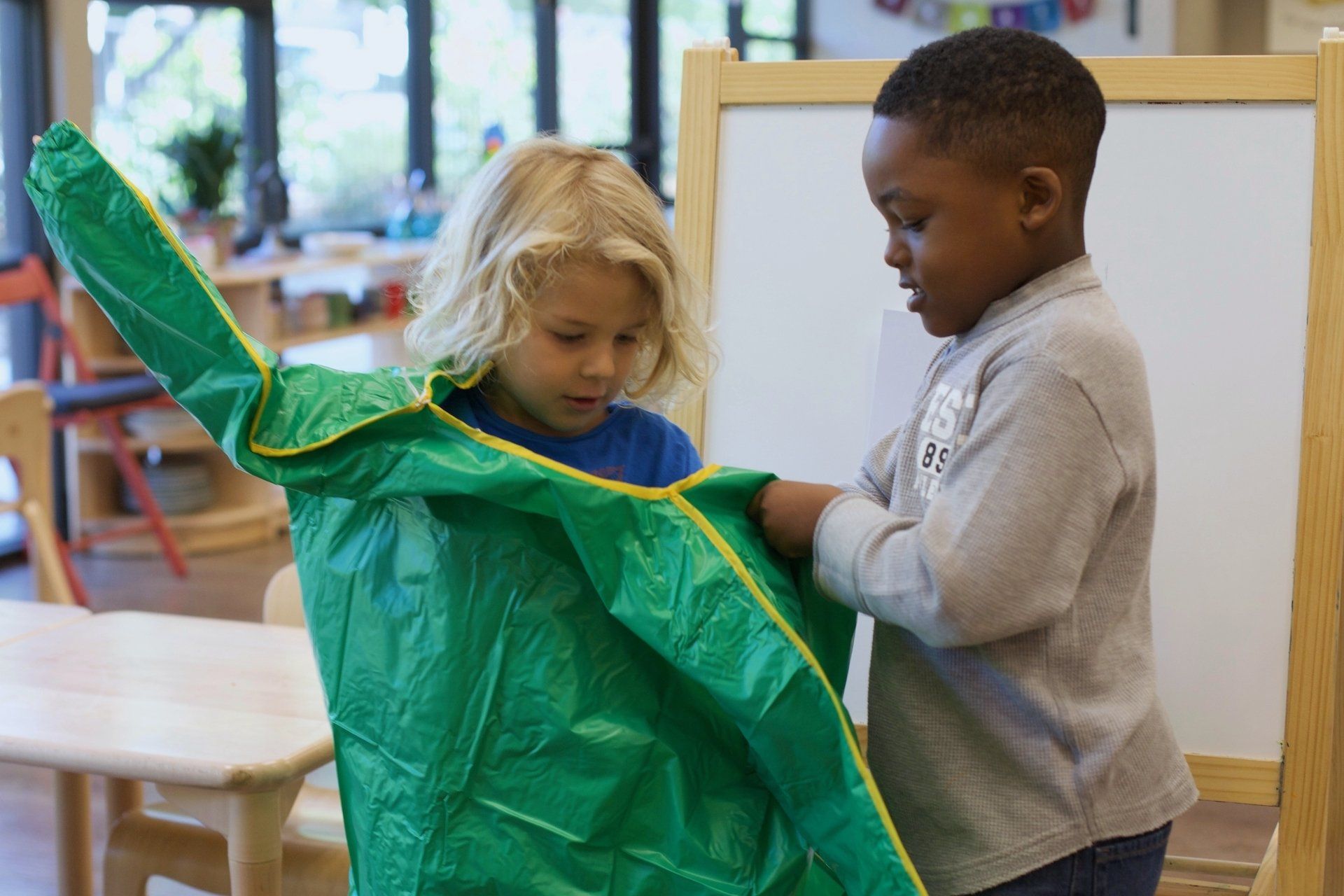Blog Layout
150 Years: Books for Adults
Sep 28, 2020

This article is part of a series that we will share throughout the 2020-2021 school year to celebrate the 150th birthday of Dr. Maria Montessori. Check back often for more posts that reflect on the past, present, and future of Montessori education.
Each month we share a list of books we recommend for families who are searching for new titles. These lists are usually composed of children’s books, but this month we decided we would share books for adults instead. Whether you’re considering Montessori for your child for the first time or are a seasoned parent who wants to learn more, we’ve got you covered.
Before you go out and purchase books for yourself, check in with us. We may have a copy to lend you!
By Dr. Montessori
Dr. Montessori herself wrote quite a few books. There are also many published books that are transcripts of talks she gave across the globe. Reading her words directly is inspiring and interesting; bear in mind they were written a century ago - the language is a bit heavier than what we are used to today!
This book was created specifically for parents. One of the most foundational pillars of Montessori education is a deep understanding of human development. This book aims to reflect on the different aspects of growth and development in young children. An invaluable resource!
The quintessential text explaining the development of our most foundational period of life: the early years. Young children explore their world, learn to socialize, and develop their personalities during this critical time.
Interested in learning more about what Montessori has to say for children aged 6-12? This is your book!
This book gives plenty of great information about Montessori education and children ages 7-12, but it is also the text in which Dr. Montessori lays out her ideas for adolescents. She describes her vision for an “experimental school for social life”, and details when that might look like.
About Dr. Montessori
Maria Montessori
by Rita Kramer
This is arguably the best biography available about Montessori. It is comprehensive and very readable; it takes readers from Montessori’s childhood through to her death and presents the facts. Though it’s an interesting read, Kramer does not attempt to glorify Montessori or hail her as something more than she was. The truth is, she really was an extraordinary woman. This journey through her life is a great read.
The Method
Montessori: The Science Behind the Genius
by Angeline Stoll Lillard
This book is a fantastic introduction for anyone who is new to the Montessori method or for those who are curious about its relevance today. Dr. Montessori was a scientist and a meticulous observer as much as she was a visionary. A century later, modern scientific research is confirming what she knew all along. Stoll Lillard discusses some of the most important foundational Montessori ideals, and examines how current studies support the work we do with children and learning.
Specifically for Parents
Montessori Madness!
By Trevor Eissler
Interested in a direct explanation of Montessori education from a parent who’s been there, done that? Eissler’s book is well loved by parents, teachers, and trainers alike. Early on in the book he describes the day when he and his wife, unhappy with the prospect of traditional schooling and hesitant to abandon their own careers to pursue homeschooling, walked into a local Montessori school to observe. “A few days later we arrived at the school and met the director.
She escorted my wife to one classroom and me to another, two of the possible classes that our kids would attend if we decided in favor of this school. I opened the door. My idea of what education should look like has never been the same since.”
How to Raise an Amazing Child the Montessori Way
by Tim Seldin
Montessori educators complete intensive training in order to properly teach children how to use the specialized materials. But that doesn’t mean you can adopt the philosophy (and implement some materials of your own) at home. Seldin offers practical advice on how we might shift our home and parenting approaches to align more with Montessori ideals.
Montessori From the Start: The Child at Home, from Birth to Age Three
by Paula Polk Lillard and Lynn Lillard Jessen
Infants and toddlers require special consideration when it comes to their development. Montessori for the youngest children incorporates the home in an important way. Lillard and Jessen, experienced Montessori educators and writers, provide simple and compelling ideas for parents to implement. Whether you’re wondering how to set up a Montessori bedroom or how to approach mealtimes, helpful tips will point you in the right direction.
The Montessori Toddler: A Parent’s Guide to Raising a Curious and Responsible Human Being
by Simone Davies
Davies enjoys a devoted following on her blog, The Montessori Notebook,
for years. Her recently published book on how to raise toddlers in a Montessori home has received overwhelmingly positive feedback. In it, she rejects the concept of the “terrible twos” and advocates for finding mutual respect, offers ideas for setting up your home in a way that fosters independence, and more.
You might also like

19 Sep, 2022
Adolescents exist between two worlds: they are no longer children but they aren’t yet adults. On this bridge to adulthood, adolescents need opportunities to develop real, meaningful, adult-level skills. They aspire to do what adults do. They are curious about how to make their own way in the adult world. As adults, we are part of an economic system. Even if we aren't using money to buy something, through our work or our hobbies we produce or consume aspects of culture. In this way, economics is about the web of interdependence we have with other people. We all depend upon the work and activity of others. Economics and Interactions If we look at economics as how people offer value in their interactions, as well as the production, distribution, and consumption of services and goods, we can really think about economics as how we organize ourselves in society. Because adolescents are building the skills for stepping into the adult world, it’s important to consider how they are developing their ability to navigate this economic aspect of adult life. How many of us had the opportunity, as adolescents, to develop the skills necessary for economic independence? How would our lives be different if, as adolescents, we had a support system so we could Oigure out a fair and reasonable cost for goods we produced, faced the reality of a proOit and loss statement, or found our way in navigating the paths of spending, saving, and sharing? Road to Achieving Economic Independence Dr. Maria Montessori realized the importance of adolescents developing these kinds of skills. In From Childhood to Adolescence, Dr. Montessori made a bold statement about our approach to education and its impact on the greater society. She stated it clearly: “The essential reform is this: to put the adolescent on the road to achieving economic independence.” So in Montessori adolescent programs, we offer our emerging young adults the opportunity to learn key skills of production and exchange. We sometimes call this “microeconomy.” The basic idea is that adolescents need opportunities to produce goods and services, and work with money and monetary systems, so they can develop an understanding and appreciation for how economies work and their own role in economic systems. Real, Meaningful, and Purposeful Work This experience can take many different forms depending upon the community. Whether running a farm stand or a holiday marketplace, adolescents get to learn key skills. They learn to balance proOit and loss. They discuss and determine how much money should be reinvested into the business to help it grow or how much money should be reinvested in the greater community. They respectfully listen to their customers’ needs and concerns and incorporate that feedback in useful ways. In order to have these learning experiences, adolescents need real, meaningful, and purposeful work. Just like young children need to actually prepare food rather than play with a pretend kitchen set, adolescents need actual experiences in creating a business plan, keeping track of income on a spreadsheet, and balancing a budget. They need to practice accounting work so they can build the skills for their own economic independence. They need to have the thrill of handfuls of cash and then face the responsibility of keeping track of those earnings. They need the experience of paying for replacement materials when they have overused key supplies. If they have developed some savings and want to invest the money, they need to Oind opportunities that align with their values. Preparing for Adult Life Too many of our young people enter the world of adult lives without having experienced their role in an economy (perhaps other than being consumers!). Economic independence is a key part of preparing for adult life. We want our adolescents to step into maturity with conOidence that they can independently navigate their new responsibilities and roles. If we give adolescents the opportunity to learn how to have a sound basis for their economic decisions, imagine where they will be when they are adults and making decisions that affect broader aspects of society!

12 Sep, 2022
In their first weeks of life, babies begin to focus their eyes and track objects. These small acts of visual control provide an important foundation for newborns who are building their neural networks. To set infants up for success, we offer a series of specially designed mobiles to aid this development. Each Montessori mobile is created with particular characteristics to help babies further develop their sense of sight, depth perception, concentration, hand-eye coordination, and more. Plus, newborns love them! Essential Characteristics of Montessori Mobiles Montessori mobiles follow a progression that parallels infant development. The first mobiles have a visual focus and begin with basic shapes. They progress to include more complicated objects and eventually become interactive and tactile. The first mobiles are simple and light enough to allow them to flow with gentle air currents. In order for infants to have the best visual experience, a mobile should be hung so that it is about 12 inches in front of them rather than directly above. When babies are lying on their back, there should be a visual line at about a 45-degree angle from their eyes to the mobile. This particular placement allows infants to see the whole mobile moving. Each mobile has visual components designed to help infants track the objects and sharpen their vision. Then after these opportunities to follow objects visually, infants begin to have more arm and hand control and might begin to reach and grasp objects nearby. To support this new ability to reach and grasp, the mobiles take a slightly different form and thus need to be easy to grasp, colorful, and safe for children to mouth. Progression of Mobiles: Visual The first four mobiles–the Munari, Octahedron, the Gobbi, and the Dancers–provide babies with meaningful visual experiences when they are just recognizing shapes and then later identifying colors.

05 Sep, 2022
In Montessori, we talk a lot about independence. However, one of the lesser known or understood aspects of Montessori is that independence isn’t the end goal. As humans, we are each wonderful, unique individuals. But we don’t exist in isolation. We live amongst other wonderful, unique individuals! In order to effectively live in community with other people, though, we need to be able to function independently. Said another way, before we can offer help to others or make ourselves useful, we need to be able to meet our own needs. How can we be independent and interdependent at the same time? We all want to make choices for ourselves, exercise our liberty, and be responsible for our own lives. At the same time, we also want to be part of something. We are designed to be both independent and be in community. These two needs are not mutually exclusive, but in fact, operate in relationship to each other. We have an innate desire to be autonomous and to belong. When we develop the ability to act for ourselves, make choices, control ourselves, and accept responsibility, we are able to be functioning, contributing members of society. We can see what needs doing and do it because we have the skills to do so. We can work with others to create solutions or produce goods and services. We can be part of a community by acting and taking responsibility for our actions, each able to contribute because we all have the skills to do so. What does this have to do with children and Montessori education? From a very young age, children are trying to exert control over their lives. Children are trying to gain functional independence from birth to about age three. In Montessori classrooms, we offer all sorts of opportunities for young children to develop skills that help them take care of their basic needs. But we don’t stop there! We also provide so many ways children can care for others and for their surroundings. Once children have mastered pouring from one pitcher to another, they are able to pour water into a vase and arrange flowers to beautify the classroom. After they learn how to sweep, they are quick to notice a spill and rush to get the dustpan and dust brush so they can help. When someone is struggling to zip their jacket, they take pride in sharing their newfound skill in service to someone else’s need. As children move into the elementary years, this service to others often takes on a slightly different form, in part because elementary-age children are developing their intellectual independence. Thus, their contribution often involves applying these newfound intellectual skills. They might notice a classmate struggling to figure out the steps in a math problem and offer support. Or when friends are in conflict, they might provide some mediation to help each party listen to the others’ perspective. In adolescence, young adults are ready to work toward being socially and economically independent. They want to figure out their place in society, grapple with real problems, and contribute in a useful way. Thus, Montessori adolescent programs offer teens the chance to develop and feel secure in their own abilities while also collaborating in real and meaningful social endeavors. In the process of running a small business, for example, adolescents are applying their intellectual skills from marketing to mathematics, while also navigating how to communicate with customers and collaborate with classmates. Why is this important? As humans, we want to achieve independence and belonging. Being independent is about learning the skills to be able to contribute in a meaningful way. All the little conquests of independence–throughout each age and stage of development–matter! When our infant reaches to grasp an object, our two-year-old demands to put their shirt on themselves, our eight-year-old argues about just and fair rules of a game, or our adolescent insists they can solve a problem with their peers, we can remember that these acts of independence are laying a foundation for our children to become part of an interdependent, harmonious society. Independence is just a step. Interdependence is the ultimate goal.
